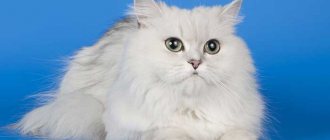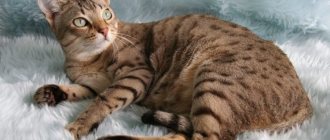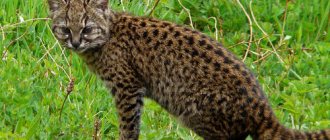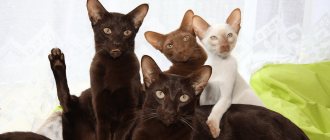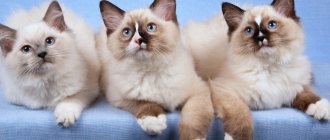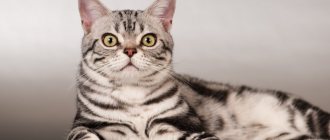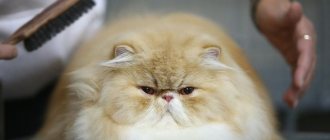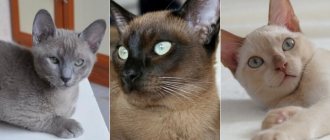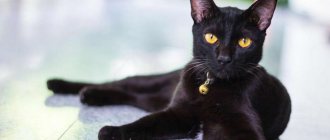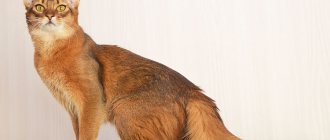History of the Asian Smoke Cat Breed
One of the varieties of this group is the smoky cat. It was bred in Great Britain through long-term selection from the existing breed of Burmese cat and the English Chinchilla Persian, well known in wide circles. Officially, the breed received recognition from the WCF, the largest cat organization in the world, only in 1990, and even then not in all countries.
What does a smoky cat look like?
Story
The history of the smoky cat began quite recently, in 1975; the first kittens of the new breed appeared only at the end of 1980.
It took more than 10 years to finally breed the breed, but it was worth it. The first name of the overseas breed was “spotted mist”, which comes from the English word smoky. Later the name Australian Mist was assigned to the breed.
For a long time, the breed was recognized only in Australia, and therefore did not spread throughout the world. More recently, the smoky cat was identified as a separate breed in the international organization of felinologists and TICA.
The most interesting thing is that the smoky cat has no Australian predecessors; they were all brought to Australia. There have never been any felines on the mainland under natural conditions.
External characteristics of Asian smoke cats
First of all, the smoky color of the cat attracts attention to the new breed. Besides this, her movements are simply mesmerizing. A coat darkened on top with a lighter silvery undercoat creates a shimmering effect.
Australian mist: smoky cat
Description of the smoky cat:
- medium-sized body with well-developed muscles;
- the tail is of medium length, the tip is rounded;
- the head is large with a slightly elongated blunt muzzle;
- weight from 5 to 7 kg (larger cats);
- the ears are straight, set high with rounded tips;
- nose with a depression in the middle, its size is medium;
- the eyes are almond-shaped, widely spaced and golden-green in color;
- The coat is of two types - short and medium length, it is of a uniform smoky color and lies tightly to the skin.
For your information! The smoky color of cats is not the only color. The breed standard stipulates reddish, black, blue, cream and even tortoiseshell colors.
Care and maintenance
Asian tabby cats are covered with short, thick hair, which they groom well themselves. The owner only needs to brush the cats once every 7-10 days with a soft brush and remove fallen hairs from furniture and carpets with a wet rubber glove.
Naturally clean animals do not require bathing. This procedure is appropriate if the pet is very dirty or is going to an exhibition. In the second case, it is recommended to bathe a week before an important event, so that the coat has time to fully recover and take on its proper appearance. You need to use a special shampoo to avoid allergic rashes on the animal’s skin.
A tabby cat's eyes require daily care. They need to be wiped with a cotton pad soaked in lotion or strong black tea. The nose is regularly inspected and cleaned of dirt accumulation. The ears are checked for the presence of parasites and, if necessary, cleaned of wax with a cotton swab once every 10 days.
The claws are trimmed once every 14 days with special pliers - they are called claw clippers. The animal scrapes the resulting unevenness on hard objects, therefore, in order to maintain the integrity of furniture, wallpaper, and carpeting, you should make sure that there is a scratching post in the house.
In general, caring for and maintaining an Asian tabby cat does not cause any great difficulties; it is enough to regularly carry out all the necessary hygiene procedures and observe the correct dosage of food volume to prevent obesity in your pet.
Cat temperament and behavior
Ocicat cat - description of the cat breed, red kitten
The smoky cat is a breed that is, by its nature, active and restless, but at the same time obedient. You just need to give her enough attention, play, pet her, so that the pet doesn’t feel abandoned and lonely. The cat is quite smart and curious. Many are amazed by her desire to take part in everything that the owner is doing.
Important! The smoky “Asian” has sociability and gets along well with other cats and pets, and small children.
Character
Despite their courageous appearance, these smoky cats are very affectionate and have a wonderful easy-going character. They get along well with other pets. These animals are not very fond of jumping on cabinets: due to their massive physique, they are poor climbers, and some individuals are even terrified of heights. Representatives of the breed are balanced and intelligent, and do not have a strong temperament. British smoky cats, photos of which can now be found in a lot of printed publications about animals, are moderately active and playful. The animal is unpretentious and easily adapts to any living conditions.
Lifestyle and Diet of Asian Smoky Cats
Abyssinian cat - color of Abyssinian cats
The lifespan of any animal depends 50% on the characteristics of its diet and lifestyle. The domestic cat owes this to its owner. The basis of nutrition for this pet, like any predator, should be protein. It makes up half of the diet, followed by 30% animal fats and 15% carbohydrate foods (greens and vegetables).
Diet
Prohibited products are:
- bones, which with their sharp edges can cause injury to the intestines;
- various kinds of products containing large amounts of spices, salt, sugar, which harm internal organs, causing their failure;
- sausages, bread, potatoes, legumes, milk, raw eggs.
Products from the owner's table are not only poorly digestible, they can cause irreparable harm to the pet's health.
Note! You should not feed your cats economy-class dry food. Apart from waste meat products, grains, bone meal and flavorings, they contain nothing useful that an animal needs for a balanced diet.
When choosing dry food for your pet, you should pay attention to its composition and ask for consumer reviews. These requirements are met by food of at least premium class. It is worth buying them in packaged packages; loose food is often of poor quality, mis-graded and expired.
Important! Mixed feeding, natural food with packaged food, can lead to disruption of the functioning of internal organs.
Description of the breed
The Asian smoky cat is one of the representatives of the Asian group. Contrary to its name, the breed is not Asian at all, but was bred in Great Britain.
The hallmark of Asian smoky is its unusual shade. The coat is dark on top and the undercoat is lighter, creating the illusion of iridescence. When the cat moves, the fur shimmers.
In addition, Asian women have a soft and flexible character. They are very affectionate and gentle, they love to be petted and enjoy spending time with their owner.
These are great play companions for children. Asian smoke cats love to run and play with everything they can get their hands on. Despite their playful disposition, they are very obedient.
Caring for Asian Smoke Cats
The animal does not require care. It is enough to comb him once a week, clean his ears, and bathe him with specially designed shampoos as he gets dirty, but not more than once a month. Typically, a cat does not need water treatments, caring for its fur on its own. Once a month, you should trim your nails and wash your eyes with a cotton swab and chamomile infusion as they become sour.
The smoky cat is initially endowed with good health, since closely related individuals did not take part in its breeding. There are many different breeds involved in her genotype. Therefore, they rarely get sick and live on average up to 15 years, although with good living conditions, timely vaccination and helminthization, and a balanced diet they can live up to 20 years.
It is advisable to visit a veterinarian every year
Siberian smoky
Unfortunately, there is no documentary evidence of when these beautiful furry creatures first appeared in Siberia. There is a version that they were brought by Russian settlers several hundred years ago. Finding themselves in a harsh climate, cats had to survive. It is quite obvious that only individuals with increased wool density were able to withstand such difficult conditions. From this we can conclude that nature itself formed the breed, using an infallible method - natural selection.
In addition, there is an opinion that wild forest cats, which passed on their genes to their offspring, also contributed to the formation of this breed. The Siberian cat is considered a native breed that was formed naturally. And the felinologists could only bring to perfection what Mother Nature had planned.
Animals of this breed have different colors - from solid to two- and three-color. According to lovers of this breed, smoky cats are especially attractive. Moreover, in this breed there are such varieties as “blue smoke”, “black smoke”, “red smoke”, etc.
In conclusion, I would like to say that no matter what breed the smoky cats are, the main thing is that they are loved and welcome in your home.
Purchasing and Costing Asian Smoky Cats
In a litter of “Asians” there are on average 3-6 kittens. They are born weighing 100 grams, blind and deaf. As they grow up, they quickly gain weight, after 2 weeks their eyes begin to see, their ears begin to hear, and after a month they are already trying to eat on their own. They are sold starting from the age of two months.
When purchasing a kitten, you should pay attention to its temperament. A healthy smoky kitten, if not resting, is in constant motion and playing with its brothers. A healthy kitten's coat is clean and shiny, without the smell of excrement. The baby’s grandparents also play an important role in his health, so it’s worth asking about their documents. When choosing a pet, you should pay attention to the kitten that will be the first to approach the outstretched hand. The baby also chooses its owner.
Important! The animal's parents must not be close relatives.
You need to buy kittens from trusted breeders, in nurseries that specialize in breeding this breed. No self-respecting owner of a breeding animal would sell their offspring on the market. By selling through clubs, owners are responsible for their pets.
It's worth choosing a playful kitten
The price of kittens depends on where they are purchased, their pedigree, and the demand of the breeder. If the parents of the children have international titles, then the price will fluctuate between 1000-1200 dollars* and more. Breeding kittens from ordinary parents with a pedigree cost around $500. On the market, a kitten of this breed can be purchased for $200-300.
Asian Tabby Health
Short-haired tabby cats inherited excellent health from their parents. They do not have any hereditary diseases. A balanced diet, proper daily care - and the animal can live up to 18 years. For a happy home for gentle, beautiful cats, you should adhere to the following rules:
- A clean home is the key to health and safety.
- Complete nutrition: food should be given in small portions several times a day, preferably at the same time.
- Availability of fresh water.
- Timely prevention of parasites, vaccination and annual medical examination.
If treated well and given proper nutrition, the health of an Asian tabby cat throughout its life will not cause any concern to the breeder. Regular visits to the veterinarian are recommended to conduct a general examination, identify and effectively eliminate possible problems.
Possible diseases
Asian tabbies are prone to colds - perhaps this is their only weak point. There should be no drafts in the house, but it is also better to avoid stuffiness and heat.
In old age, a tabby, like a cat of any breed, may develop unpleasant illnesses:
- joints;
- kidneys and genitourinary system;
- the risk of stroke increases.
All these troubles can be avoided if you regularly take your cat for a medical examination and donate blood for analysis. Many diseases in the first stages are asymptomatic, so there is a risk of starting them. It's better to play it safe and get a veterinary examination.
Reproductive health
The Asian tabby enters reproductive age at 6 months of age. But the first few heats should be skipped; the ideal mating period is 1 year. On average, shorthair cats give birth to 4-6 kittens.
If you need an animal for communication and admiration, take care to sterilize the female or castrate the male. Timely surgery will not affect the pet’s health: the operation is performed under local or general anesthesia in a specialized clinic.
Having decided to continue the cat family, the breeder must check the pedigree of the cat and the cat, the availability of a veterinary passport with vaccinations. It is worth asking about the fate of previous litters, which will make sure that the animals being crossed are purebred and there are no genetic diseases.
Other smoky cat breeds
The smoky color of cats has always been very popular. People were attracted by their unusual appearance and the ability of their fur to change color depending on the lighting. Many different breeds have been bred with friendly personalities and this coloration.
Russian Blue with green eyes
Bright, all shades of green, eyes of this breed are its calling card. Any other color is considered a defect in the breed. By the color of the greenery you can determine whether you belong to a particular tribal line.
Note! Kittens are born with blue eyes and only by four months, or even a year, their final color is established.
The coat is short, monochromatic blue, shimmering with silver.
Russian blue breed
British shorthair and longhair
The British Longhair evolved from the Shorthair breed due to a gene mutation resulting from crossing with Persian and Somali cat representatives. At first, kittens with long hair were discarded, but then they received recognition from international clubs. Now their popularity is growing, they participate in exhibitions.
Apart from the length of the coat, there are no other differences between the breeds. In their appearance, short-haired “British” cats resemble the Scottish breed of cats, but unlike “Scots” they do not have fold-eared kittens, all ears are erect. Longhairs are similar to Siberian cats.
British Longhair
American Curl
A medium-sized cat with short to semi-long hair that is popular in the United States. Its characteristic feature is the ears twisted back with a rotation angle of 90-180°.
Note! Kittens are born with straight ears, but after a few days they begin to curl and are fully formed by 4 months.
American Curl
Maine Coon
The breed is a native cat that originated in the northeastern United States. It owes its name to the state of Maine. Its name translated from English means “Manx raccoon”. This is the largest cat breed, its height at the withers reaches 40 cm, and its body length is more than a meter. A distinctive feature is the tassels at the tips of the ears. The coat is silky, long and soft.
Maine Coon
American Ringtail
Representatives of this breed come in short-haired and long-haired varieties. Their distinguishing feature is their ring-shaped tail. Homeland of the California breed. The breed became widespread in Canada.
The breed is considered experimental and has not yet received recognition by major associations of felinologists. The coat is short and medium with undercoat.
Important! Representatives with long coats have no undercoat.
American Ringtail
American Bobtail (Yankee Bob)
The breed is a typical representative of American breeders, their beauty and pride. The distinctive features of the bobtail are its athletic build and short tail, which varies in appearance, length and width even among kittens of the same litter.
In all its appearance, the Yankee Bob resembles a wild predator. The breed is very rare; at the beginning of this century, only a little more than 200 representatives of these cats were registered in the world.
American Bobtail
California Spangled
This breed has made it possible to have a miniature leopard or tiger at home, the Spangled is so similar to its wild relatives. The breed was developed by Hollywood screenwriter P. Casey through ten years of breeding work. Due to its appearance, this breed is also called radiant, the reason for this is the dark spots that cover the entire back. The coat comes in 8 colors: from light beige to dark gray.
California Spangled
Tabby Color Genetics
Tabby patterns are caused by three different gene loci and one modifier.
The Agouti gene, with its two alleles A and a, controls whether or not the Tabby pattern is present. The dominant A expresses the basic Tabby pattern, and the recessive "non-Agouti" or "hypermelanistic" allele indicates its absence. Solid (black or blue) cats have an "a" combination that hides the striped pattern, although traces of it can sometimes be seen (called a "ghost stripe"). This basic pattern, whether classic, tabby, spotted or ticked, is most easily distinguishable in bright light during the early stages of a kitten's development and into adulthood on the tail.
However, the Agouti gene only controls the production of black pigment, so a cat with the O allele (responsible for orange or red color) will still express a tabby pattern. As a result, both red cats and red spots on cat skins will always display striped patterns.
The tabby cat's primary pattern gene is dominant, so it is a cat with the Mc genotype (mc or Mc) - mackerel.
The "Mc" set establishes the basic pinstripe pattern (striped mackerel) that underlies the coat. Mc is the wild type Tabby gene. Classic tabby cats are animals that have two copies of the recessive mc, so they are carriers of the mc/mc allele. This is a recessive mutant (not wild type) mc gene that produces the spotted pattern and appears in the cat as the classic pattern of thick stripes with a bullseye pattern on the sides.
The spotted gene is directly related to the Mc gene, it “breaks” the Tabby stripe lines, turning them into spots. It is also dominant, designated Spotted or Sp (sp or Sp). Sp together with Mc and Agouti make up various combinations - mc and Mc/Mc and A/ a and A/A.
The Ticked tabby pattern is at a different gene locus than the Mackerel and Classic tabby patterns, and is epistatic to (influenced by) other patterns. The dominant Ta/ta mutation masks any other Tabby pattern, creating a striped background or agouti stripe with virtually no lines. If the Ticked tabby pattern gene is present, any other Tabby pattern is masked.
Cats homozygous for the marked allele (Ta/ta) have fewer medallion defects than cats heterozygous for the marked allele. When a cat of this genetic makeup is selectively bred for lack of faults and broad stripes on the hair shaft, the resulting pattern is called shaded.
There are additional alleles and even additional genes influencing Tabby patterns that have also been identified and postulated.
The three most common alleles in order of dominance are Ta, the allele for ticked patterns as in the Abyssinian type, Tm, for tabby mackerel, and the recessive tb for classic.
The Ta allele is dominant over Tm and tb.
A cat with the Ta allele will express a ticked tabby pattern (only with stripes on the paws if there is only one copy and none at all if there are two), and a cat with two tb alleles will express the classic stripe pattern.
The wild type is the mackerel (the stripes look like thin fish bones and can break up into linear markers or spots), the most common variety is the classic striped pattern (wide stripes, curls and spirals of dark color on a pale background, usually with bullseye on the side) and, Perhaps the most famous of the less common tabby cat designs is the “swoosh.”
Classic tabbies are most often found in Iran, England and the lands that were once part of the British and Persian empires. The gene responsible for differentiation pattern formation was named transmembrane Q (Taqpep), which also underlies the coat color of the king cheetah.
King Cheetah
Other pattern modifier genes are responsible for creating different types of spotting, many of which are variations of the basic mackerel or classic pattern. There are also hypothetical factors that influence the timing and frequency of Agouti shifts, affecting the width of its band and the quantity and quality of alternating eumelanin and pheomelanin lines on individual hairs.
There is also a gene, not yet identified but believed to be related to the Agouti gene, in the Chausie breed that produces silvery black fur similar to the Abyssinian. It is assumed that the "gray" phenomenon is inherited from the hybridization of the domestic cat with the House (Felis chaus).
Black Chausie
The pigment gene, I/i, is also inhibited. The dominant allele (I) produces hairs with tips of a different color, which are completely colored only on it and have a white base. This allele appears to interact with other genes to cause varying degrees of coloration, ranging from dark-tipped silver tabby to lightly shaded silver and silver chinchilla. The inhibitor gene interacts with the non-Agouti genotype (I-aa) to produce a color known as smoke.
The homozygous recessive genotype combined with the agouti gene (iiA) produces the Tabby's coloration, which can range across the spectrum from a deep-patterned brown tabby to a light yellowish, slightly tinted golden or chinchilla gold. Orange cats with the inhibitor (IO) gene are commonly called "cameos".
Still, the Tabby pattern exists thanks to the Agouti gene. Their stripes have an even distribution of pigment, while the background consists of banded hairs. Tabby cats usually have the following characteristics:
- Mark in the form of the letter "M" on the forehead. Visible in marked tabby cats, but difficult to distinguish in darkened silver and golden animals.
- Thin “pencil” lines on the muzzle. Clearly visible in tabby cats, but more difficult to notice in darkened silver/golden pets.
- Black "eyeliner" and white or pale fur around it.
- Pigmented lips and paw pads.
- Pink nose with darker pigment.
- Ring “girth” of the body, legs and tail. The stripes on the torso disappear when the color is ticked.
Education and training
Despite the restless and eccentric nature, there are no problems in raising the Asian Smokey. This is a very smart breed. Having scolded your pampered girl once for a torn curtain or a broken flower, you can be sure that she will understand that you can’t do that.
The Asian cat needs constant attention and affection. If you don't have at least an hour a day to play and cuddle your pet, this breed is not for you. Without this, the cat will feel unnecessary to you and will suffer greatly from this.

